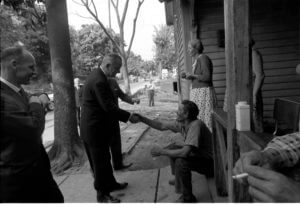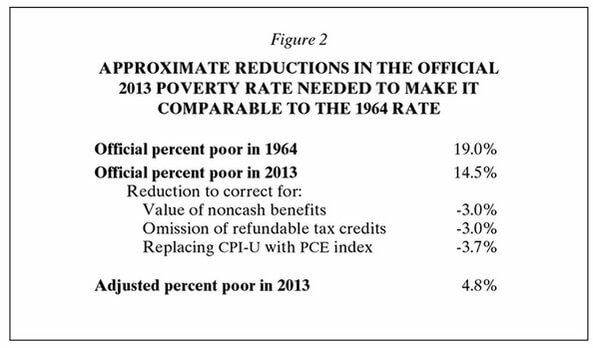Ricochet is the best place on the internet to discuss the issues of the day, either through commenting on posts or writing your own for our active and dynamic community in a fully moderated environment. In addition, the Ricochet Audio Network offers over 50 original podcasts with new episodes released every day.
 What Has the War on Poverty Gotten Us?
What Has the War on Poverty Gotten Us?

President Lyndon B. Johnson in May 1964 on his poverty tour.
The Economist explores the legacy of 1990s welfare reform, especially in light of poverty research by Kathryn Edin and Luke Shaefer suggesting some 1.5 million US households are living on more than $2 a day as a result. From the newspaper:
Other wonks—on the right but also including former members of the Clinton administration—take issue with the claims made by Ms Edin and Mr Shaefer. A forthcoming paper by Scott Winship of the Manhattan Institute, a think-tank, argues that, after factoring in non-cash benefits and underreported income, a sunnier picture emerges. The only groups he finds to be worse off than they were in 1996, including childless households, were unaffected by the reform. Meanwhile, he argues that “children, in particular those in single-mother families—are significantly less likely to be poor today than they were before.” As for Ms Edin’s and Mr Shaefer’s most emotive claim, he says, “no one in America lives on $2 a day.”
Mr Winship is right that consumption is a better measure of poverty than income, and that there is scant evidence the reform increased the ranks of the poor. Yet cash is important; without the means to pay a phone bill or a haircut, no one, however well-nourished and sheltered, is liable to kick on. It is hard not to conclude that, even allowing for underreporting, the reform has denied too many poor Americans such means; between 1993 and 2013 the percentage of households on food stamps who had no cash income more than doubled.
Instead of quibbling over the past, it would be better to ponder what America should do to cut poverty—and here there is more agreement, or at least potential for compromise. Concerned Republicans such as Paul Ryan, the Speaker of the House, argue for work-requirements to be extended to food stamps and other benefits. The record suggests that is a good idea; especially if, as Democrats want, in-work benefits such as tax credits are also boosted. But the safety-net for the least capable needs strengthening. That should include giving them more cash, by increasing TANF or limiting the ability of states to plunder it.
Here’s another way of looking at American poverty. The official US poverty rate is 14.8% — with an update due next month — or 2.3 percentage points higher than in 2007, a year which ended with the official start of the Great Recession. By comparison, the poverty rate in 1964 when LBJ announced the War on Poverty was 19%. So some improvement in that top-line number.
But also that number is misleading and ignores much. How much? In a blog post earlier this summer, my colleague Robert Doar highlighted this chart from social policy scholar Christopher Jencks:

The New York Review of Books
And Doar:
Published in EconomicsThis argument about the misleading nature of the official poverty rate was not new. It has been pointed out for years (including most convincingly by AEI’s Nick Eberstadt in his 2008 book The Poverty of The Poverty Rate.) But coming from Jencks, and appearing in the New York Review of Books, his article made the definitive case that our $800 billion annual federal investment in anti-poverty programs have significantly relieved the material hardship of the poor (a point that Robert Rector at the conservative Heritage Foundation has made for years.)




Americans don’t live in poverty, as defined by not getting enough to eat.
“Poverty” is not a fluid number.
The aqueducts?
Technically poverty is a fluid number. Absolute poverty means poverty that prevents you from getting enough to eat. It is a much more fixed concept.
Before the 20th Century, Poverty only meant not getting enough to eat.
When the poverty rate is defined in terms of percentage of average household income, it’s pretty clear to see that the system is designed not to eliminate poverty. It’s the exact opposite of Lake Wobegon.
A more valid question, I posit, is: “What has the war on poverty cost us?“
Are the people living on welfare and other benefits flourishing? Are the escaping dependency? Are they getting educated? Are these negative answers changed by more welfare? Is the remote non accountable Federal government capable of designing and administering national programs to change the disasters their programs have created? Are we capable as a nation to learn the obvious lessons here?